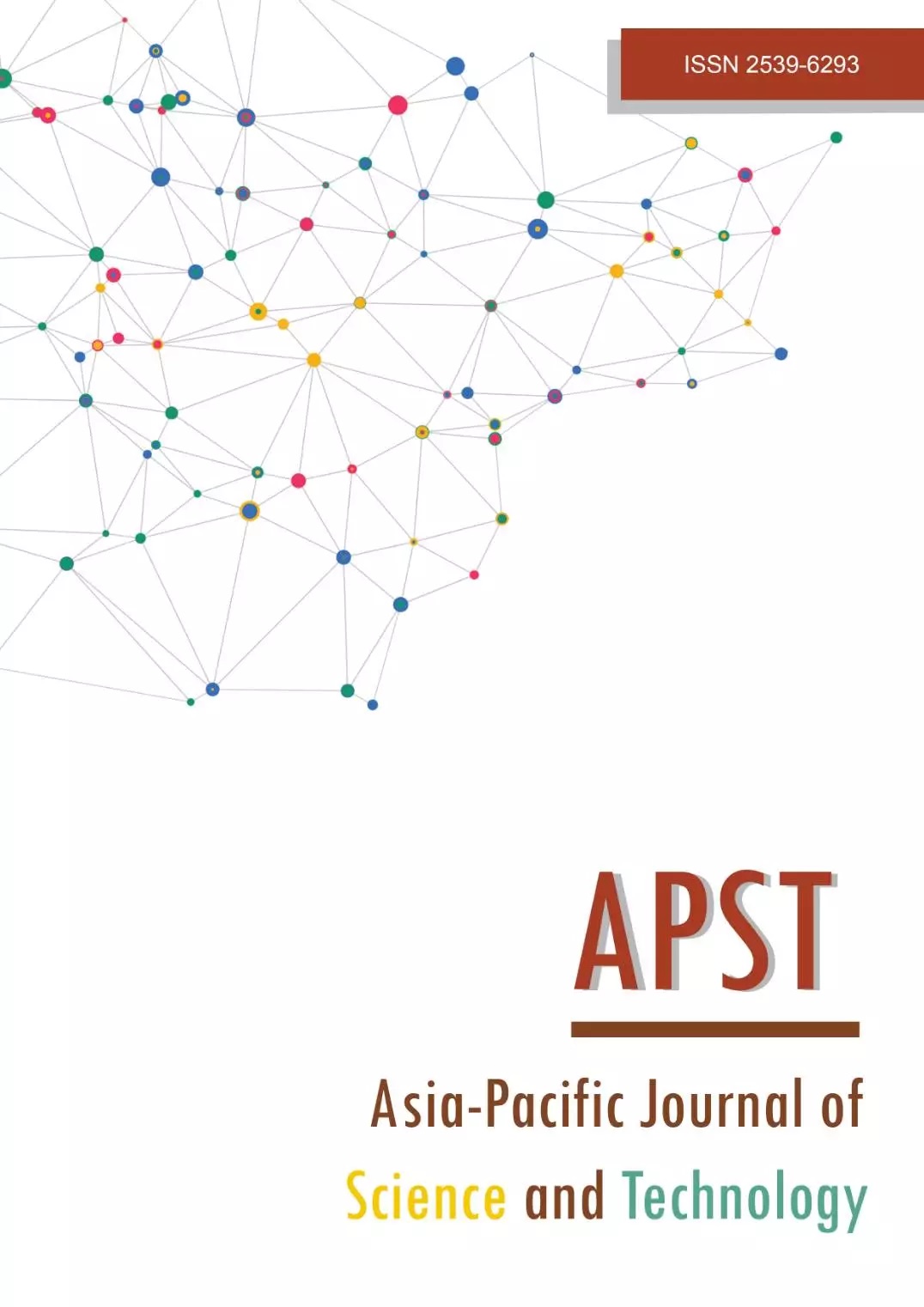Applying of economic index data for municipal solid waste quantity prediction in Thailand
Main Article Content
Abstract
The population increased from past to present until the expansion of the community brought economic and prosperity in the society, but it also increases the municipal solid waste quantity. This research has studied the correlation between municipal solid waste quantity with economic growth factors in Thailand since 1993- 2019 to create an equation to predict the changes of municipal solid waste quantity that may occur in the future. This information analysis was organized into 4 datasets, 27 years (108 quarters: 1993-2019), 9 years (36 quarters: 1993-2001), 9 years (36 quarters: 2002-2010), and 9 years (36 quarters: 2011-2019) found that the population increase of all of 27 years from 58.44 million people in 1993 to 66.56 million people in 2019 same as municipal solid waste quantity constantly increase from 10.91 million tons in 1993 to 28.71 million tons in 2019, Causing the difference of change of each year (36 quarters) between municipal solid waste quantity with economic growth factors in Thailand. The correlation between municipal solid waste quantity with economic growth factors found that most of all 4 datasets have a correlation with almost all economic growth factors (R>0.6) except retail sales index (36 quarters: 2002-2010) and consumer price index, core consumer price index (36 quarters: 2011-2019) have a correlation less than 0.6 (R<0.6). The creation of equation municipal solid waste quantity predict from 4 datasets show that 2 datasets were suitable for application considering by R2 value more than 0.6 were equation predict of 27 years (108 quarters: 1993-2019) for prediction in long-times between 10-27 years and equation predict of 9 years (36 quarters: 2011-2019) for prediction in short-times between 1-9 years.
Article Details

This work is licensed under a Creative Commons Attribution-NonCommercial-NoDerivatives 4.0 International License.
References
World Bank [Internet]. Washington: The Institute; c1944 [cited 2021 Feb 20]. Trends in solid waste management. Available from: https://datatopics.worldbank.org/what-a-waste/trends_in_solid_waste_management.html.
Pollution Control Department [Internet]. Bangkok: The Ministry; c1992 [cited 2021 Feb 1]. Municipal solid waste quantity in Thailand 1993-2003. Available from: http://pcd.go.th/info_serv/waste_wastethai.htm.
Department of Provincial Administration [Internet]. Bangkok: The Ministry; c1892 [cited 2021 Feb 1]. Registration. Available from: https://stat.bora.dopa.go.th/stat/y_stat45.html.
Badgie D, Samah MAA, Manaf LA, Muda AB. Assessment of municipal solid waste composition in Malaysia: management, practice, and challenges. Polish J Environ Stud. 2012;21(3):539-547.
Jereme I, Begum R, Talib B, Siwar C, Alam M. Assessing problems and prospects of solid waste management in Malaysia. e-BANGI J. 2015;10(2):70-87.
Furuoka F. Population growth and economic development: new empirical evidence from Thailand. Econ Bull. 2009;29(1):1-4.
Inglezakis V, Zorpas A, Venetis C, Loizidou M, Moustakas K, Ardeleanu N, et al. Municipal solid waste generation and economic growth analysis for the years 2000-2013 in Romania, Bulgaria, Slovenia and Greece. Fresenius Environ Bull. 2012;21(8b):2362-2367.
Razzaq A, Sharif A, Najmi A, Tseng ML, Lim MK. Dynamic and causality interrelationships from municipal solid waste recycling to economic growth, carbon emissions and energy efficiency using a novel bootstrapping autoregressive distributed lag. Resour Conserv Recycl. 2021;166:105372.
McBean EA, Fortin MH. A forecast model of refuse tonnage with recapture and uncertainty bounds. Waste Manag Res. 1993;11(5):373-385.
Niessen WR, Alsobrook AF. Municipal and industrial refuse: composition and rates. National Incinerator Conference, American Society of Mechanical Engineers; 1970 May 17-20; New York, United States. New York; ASME; 1970. p. 319-337.
Gupta S, Mohan K, Prasad R, Gupta S, Kansal A. Solid waste management in India: options and opportunities. Resour Conserv Recycl. 1998;24(2):137-154.
Bach H, Mild A, Natter M, Weber A. Combining socio-demographic and logistic factors to explain the generation and collection of waste paper. Resour Conserv Recycl. 2004;41(1):65-73.
Gay AE, Beam TG, Mar BW. Cost-effective solid-waste characterization methodology. J Environ Eng. 1993;119(4):631-644.
UNEP [Internet]. Stockholm: The Organization; c1972 [cited 2021 Feb 20]. Summary Report Waste Management. Available from: https://www.unep.org/resources/report/waste-management-asean-countries
- summary-report.
Chang NB, Pan YC, Huang SD. Time series forecasting of solid waste generation. J Resour Manage Technol. 1993;21(1):1-10.
Box GE, Jenkins GM, Reinsel GC, Ljung GM. Time series analysis: forecasting and control. 5th ed. New Jersey; John Wiley & Sons; 2015.
Granger CW. Forecasting in business and economics. 2nd ed. Massachusetts; Academic Press; 2014.
Chung SS. Projecting municipal solid waste: The case of Hong Kong SAR. Resour Conserv Recycl. 2010;54(11):759-768.
Pollution Control Department [Internet]. Bangkok: The Ministry; c1992 [cited 2021 Feb 1]. Municipal solid waste quantity in Thailand 2004-2019. Available from: https://thaimsw.pcd.go.th/report1.php?year=
Bank of Thailand [Internet]. Bangkok: The Organization; c1942 [cited 2021 Jan 10]. World Economic Indicators. Available from: https://www.bot.or.th/Thai/Statistics/Indicators/Pages/default.aspx
Tanoue M, Taguchi R, Nakata S, Watanabe S, Fujimori S, Hirabayashi Y. Estimation of direct and indirect economic losses caused by a flood with long‐lasting inundation: application to the 2011 Thailand flood. Water Resour Res. 2020;56(5):1-52.
Poapongsakorn N, Meethom P. Impact of the 2011 floods, and flood management in Thailand. Sawada Y, S Oum, editors. Economic and welfare impacts of disasters in East Asia and policy responses. 8th ed. Jakarta: ERIA; 2012. p. 247-310.
Thamakorn T. Economic indicator. J BEC. 2008;28:37-42.
Gen E. Diversifying retail and distribution in Thailand. CSEAS J [Internet]. 2013 [cited 2021 Jan 9]; xii:680-682. Available: http://englishkyoto-seas.org/wp-content/uploads/SEAS_0303_BookReview_Vee
rayooth-Kanchoochat.pdf.


